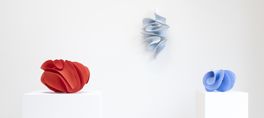This exhibition is the first to bring together paintings of women in later Chinese painting, known as meiren hua or beautiful women paintings, and to attempt to situate the works within the social and economic contexts of the High Qing period (mid-seventeenth to late eighteenth century). These paintings have often been understood as images of high status women, either members of the court or other privileged individuals, but Beauty Revealed challenges that viewpoint. We revisit the visual codes within the paintings to assert that the women depicted are primarily of the courtesan class, a discovery that leads to new ways of viewing and understanding this genre.
Borrowing seldom-before-utilized techniques from the West, including one-point perspective and heavy opaque colors, the artists, many of them unknown professional painters, attempt a realism not previously seen in Chinese painting. Rather than the willowy beauty depicted in a garden setting or surrounded by family among luxurious furnishings typical of earlier periods, these paintings portray a single, near life-size figure, often in a brazenly unladylike posture. For example, the direct gaze of the woman in Putting out the Lamp, addressed to the (presumably male) intended viewer, offers a suggestive undercurrent of greater intimacy, one of the hallmarks of this genre. Other codes of accessibility include the woman’s relaxed posture with right leg drawn up under left, the open sleeves that expose her arms, and the highly stylized extension of her right hand in a controlled gesture reaching to snuff out the light. Her expression engages the audience in a way never before seen in Chinese figure painting.
In addition to eight paintings from BAM/PFA’s own collection, Beauty Revealed brings together loans from institutions and private collections from around the U.S. and Europe. It is organized into distinct sections that explore the intimate life of women within the garden, home, bath, and brothel. The exhibition challenges the long-held preconceptions of intention in Chinese painting and sheds new light on the field, opening previously unexplored areas of interpretation and use.
Beauty Revealed is organized by Senior Curator for Asian Art Julia M. White in collaboration with UC Berkeley Professor Emeritus James Cahill. The exhibition is made possible in part by the National Endowment for the Arts; an anonymous foundation; the E. Rhodes and Leona B. Carpenter Foundation; Sheila Keppel; Mary Ellen Anderson; the Chan Foundation; Arnold and Jr-jye Chang; Jane R. Lurie; Judy Andrews and Kuiyi Shen in honor of Professor James Cahill; Asian Art Department, Bonhams; Fred Levin and Nancy Livingston, The Shenson Foundation in memory of Ben and Jess Shenson; and the UC Berkeley Doreen B. Townsend Center for the Humanities. The exhibition catalog is made possible by contributions from Grace Chang and Jennifer Chang Chernick, John and Julia Curtis, Hok Pui and Sally Yu Leung, and Howard and Mary Ann Rogers. Special thanks to our media sponsor World Journal.
show less
Borrowing seldom-before-utilized techniques from the West, including one-point perspective and heavy opaque colors, the artists, many of them unknown professional painters, attempt a realism not previously seen in Chinese painting. Rather than the willowy beauty depicted in a garden setting or surrounded by family among luxurious furnishings typical of earlier periods, these paintings portray a single, near life-size figure, often in a brazenly unladylike posture. For example, the direct gaze of the woman in Putting out the Lamp, addressed to the (presumably male) intended viewer, offers a suggestive undercurrent of greater intimacy, one of the hallmarks of this genre. Other codes of accessibility include the woman’s relaxed posture with right leg drawn up under left, the open sleeves that expose her arms, and the highly stylized extension of her right hand in a controlled gesture reaching to snuff out the light. Her expression engages the audience in a way never before seen in Chinese figure painting.
In addition to eight paintings from BAM/PFA’s own collection, Beauty Revealed brings together loans from institutions and private collections from around the U.S. and Europe. It is organized into distinct sections that explore the intimate life of women within the garden, home, bath, and brothel. The exhibition challenges the long-held preconceptions of intention in Chinese painting and sheds new light on the field, opening previously unexplored areas of interpretation and use.
Beauty Revealed is organized by Senior Curator for Asian Art Julia M. White in collaboration with UC Berkeley Professor Emeritus James Cahill. The exhibition is made possible in part by the National Endowment for the Arts; an anonymous foundation; the E. Rhodes and Leona B. Carpenter Foundation; Sheila Keppel; Mary Ellen Anderson; the Chan Foundation; Arnold and Jr-jye Chang; Jane R. Lurie; Judy Andrews and Kuiyi Shen in honor of Professor James Cahill; Asian Art Department, Bonhams; Fred Levin and Nancy Livingston, The Shenson Foundation in memory of Ben and Jess Shenson; and the UC Berkeley Doreen B. Townsend Center for the Humanities. The exhibition catalog is made possible by contributions from Grace Chang and Jennifer Chang Chernick, John and Julia Curtis, Hok Pui and Sally Yu Leung, and Howard and Mary Ann Rogers. Special thanks to our media sponsor World Journal.
This exhibition is the first to bring together paintings of women in later Chinese painting, known as meiren hua or beautiful women paintings, and to attempt to situate the works within the social and economic contexts of the High Qing period (mid-seventeenth to late eighteenth century). These paintings have often been understood as images of high status women, either members of the court or other privileged individuals, but Beauty Revealed challenges that viewpoint. We revisit the visual codes within the paintings to assert that the women depicted are primarily of the courtesan class, a discovery that leads to new ways of viewing and understanding this genre.
Borrowing seldom-before-utilized techniques from the West, including one-point perspective and heavy opaque colors, the artists, many of them unknown professional painters, attempt a realism not previously seen in Chinese painting. Rather than the willowy beauty depicted in a garden setting or surrounded by family among luxurious furnishings typical of earlier periods, these paintings portray a single, near life-size figure, often in a brazenly unladylike posture. For example, the direct gaze of the woman in Putting out the Lamp, addressed to the (presumably male) intended viewer, offers a suggestive undercurrent of greater intimacy, one of the hallmarks of this genre. Other codes of accessibility include the woman’s relaxed posture with right leg drawn up under left, the open sleeves that expose her arms, and the highly stylized extension of her right hand in a controlled gesture reaching to snuff out the light. Her expression engages the audience in a way never before seen in Chinese figure painting.
In addition to eight paintings from BAM/PFA’s own collection, Beauty Revealed brings together loans from institutions and private collections from around the U.S. and Europe. It is organized into distinct sections that explore the intimate life of women within the garden, home, bath, and brothel. The exhibition challenges the long-held preconceptions of intention in Chinese painting and sheds new light on the field, opening previously unexplored areas of interpretation and use.
Beauty Revealed is organized by Senior Curator for Asian Art Julia M. White in collaboration with UC Berkeley Professor Emeritus James Cahill. The exhibition is made possible in part by the National Endowment for the Arts; an anonymous foundation; the E. Rhodes and Leona B. Carpenter Foundation; Sheila Keppel; Mary Ellen Anderson; the Chan Foundation; Arnold and Jr-jye Chang; Jane R. Lurie; Judy Andrews and Kuiyi Shen in honor of Professor James Cahill; Asian Art Department, Bonhams; Fred Levin and Nancy Livingston, The Shenson Foundation in memory of Ben and Jess Shenson; and the UC Berkeley Doreen B. Townsend Center for the Humanities. The exhibition catalog is made possible by contributions from Grace Chang and Jennifer Chang Chernick, John and Julia Curtis, Hok Pui and Sally Yu Leung, and Howard and Mary Ann Rogers. Special thanks to our media sponsor World Journal.
read more
Borrowing seldom-before-utilized techniques from the West, including one-point perspective and heavy opaque colors, the artists, many of them unknown professional painters, attempt a realism not previously seen in Chinese painting. Rather than the willowy beauty depicted in a garden setting or surrounded by family among luxurious furnishings typical of earlier periods, these paintings portray a single, near life-size figure, often in a brazenly unladylike posture. For example, the direct gaze of the woman in Putting out the Lamp, addressed to the (presumably male) intended viewer, offers a suggestive undercurrent of greater intimacy, one of the hallmarks of this genre. Other codes of accessibility include the woman’s relaxed posture with right leg drawn up under left, the open sleeves that expose her arms, and the highly stylized extension of her right hand in a controlled gesture reaching to snuff out the light. Her expression engages the audience in a way never before seen in Chinese figure painting.
In addition to eight paintings from BAM/PFA’s own collection, Beauty Revealed brings together loans from institutions and private collections from around the U.S. and Europe. It is organized into distinct sections that explore the intimate life of women within the garden, home, bath, and brothel. The exhibition challenges the long-held preconceptions of intention in Chinese painting and sheds new light on the field, opening previously unexplored areas of interpretation and use.
Beauty Revealed is organized by Senior Curator for Asian Art Julia M. White in collaboration with UC Berkeley Professor Emeritus James Cahill. The exhibition is made possible in part by the National Endowment for the Arts; an anonymous foundation; the E. Rhodes and Leona B. Carpenter Foundation; Sheila Keppel; Mary Ellen Anderson; the Chan Foundation; Arnold and Jr-jye Chang; Jane R. Lurie; Judy Andrews and Kuiyi Shen in honor of Professor James Cahill; Asian Art Department, Bonhams; Fred Levin and Nancy Livingston, The Shenson Foundation in memory of Ben and Jess Shenson; and the UC Berkeley Doreen B. Townsend Center for the Humanities. The exhibition catalog is made possible by contributions from Grace Chang and Jennifer Chang Chernick, John and Julia Curtis, Hok Pui and Sally Yu Leung, and Howard and Mary Ann Rogers. Special thanks to our media sponsor World Journal.
show less
Date/Times:
Berkeley Art Museum and Pacific Film Archive (BAMPFA)
91 Upcoming Events
2155 Center Street, Berkeley, CA 94720
The Best Events
Every Week in Your Inbox
From Our Sponsors
UPCOMING EVENTS
Great suggestion! We'll be in touch.
Event reviewed successfully.








